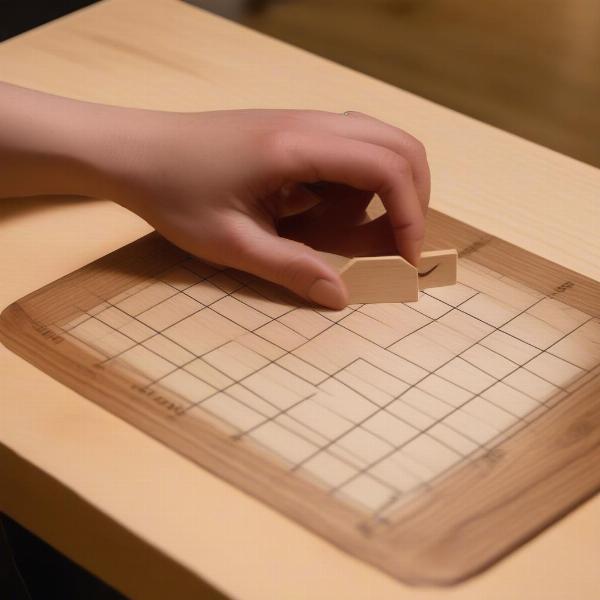Creating your own sequence card game board opens up a world of personalized fun. Whether you’re looking for a travel-friendly version, a giant outdoor game, or simply want to customize the design, building your own board is surprisingly easy. This guide will walk you through everything you need to know, from choosing the right materials to adding your own creative flair.
Planning Your Sequence Card Game Board
Before diving into construction, consider these key factors. What size do you envision? A smaller board is perfect for portability, while a larger one is great for group play. Think about the material: wood, fabric, or even a roll-up mat? Your choice will influence the durability and overall look. Finally, consider the design. Will you stick with the traditional grid or add a unique twist? This is your chance to get creative!
Gathering Your Materials
Once you have a vision, it’s time to gather your supplies. For a wooden board, you’ll need a piece of plywood or MDF, paint, and sealant. If fabric is your choice, grab some durable canvas, fabric markers, and maybe even some embellishments. Don’t forget rulers, pencils, and a good eraser for marking your grid. You’ll also need a reference image of a standard Sequence board to ensure accuracy in card placement.
Building Your Sequence Card Game Board: A Step-by-Step Guide
- Prepare your surface: Sand the wood smooth or iron out any wrinkles in the fabric. This creates a clean base for your design.
- Mark the grid: Using a ruler and pencil, carefully draw a 10×10 grid. Refer to your standard Sequence board for correct card placement and spacing. Precision is key for gameplay.
- Fill in the squares: Paint or draw the card faces in each grid square. Double-check your reference to ensure accuracy. This is the most time-consuming part, so take your time and enjoy the process.
- Add finishing touches: Seal the wooden board for protection. If using fabric, consider adding a backing for stability. Personalize your board with a custom border, logo, or other design elements.
 Creating the Grid for a Custom Sequence Board
Creating the Grid for a Custom Sequence Board
Different Materials for Different Boards
Choosing the right material for your sequence card game board can dramatically impact its durability, portability, and aesthetic appeal. Let’s explore some popular options. Wood provides a classic, sturdy surface. Fabric offers flexibility and portability, ideal for travel. A roll-up mat is another space-saving option, perfect for on-the-go gaming. Consider your needs and preferences when making your selection.
Designing Your Unique Sequence Board
While the traditional grid works perfectly, don’t be afraid to get creative with your design. Think about incorporating themed artwork, adding a personalized border, or even using different shapes for your grid. This is your opportunity to make your sequence board truly one-of-a-kind. Perhaps you’re a fan of a particular sports team? Incorporate their colors and logo. The possibilities are endless!
Tips for a Professional Finish
For a truly polished look, consider these tips. Use high-quality paint or markers to ensure vibrant colors that won’t fade. Apply a sealant to wooden boards for added protection. If working with fabric, use a heat setting to make your design permanent. These small details can make a big difference in the overall look and longevity of your custom board.
Making Your Sequence Board Last
Once you’ve put in the effort to create a custom sequence card game board, you want it to last. Store your board flat to prevent warping or bending. Clean it with a damp cloth after each use. Avoid exposing it to extreme temperatures or moisture. With proper care, your handmade board will provide countless hours of enjoyment for years to come.
“A well-made, personalized Sequence board elevates the entire gaming experience,” says renowned game designer, Amelia Cartwright. “It becomes more than just a game; it’s a cherished creation.”
Expanding Your Sequence Experience
Creating your own board is just the beginning. Consider customizing your playing pieces, adding unique game variations, or even designing your own custom cards. With a little imagination, you can transform Sequence into a truly personalized gaming experience.
Conclusion
Making your own sequence card game board is a rewarding project that combines creativity and practicality. With a little planning and effort, you can create a unique and durable board that will be enjoyed for years to come. So, gather your supplies, unleash your creativity, and get ready to enjoy a personalized Sequence experience.
FAQ
- What is the standard size of a Sequence board? The traditional board is a 10×10 grid.
- Can I use any type of paint on a wooden board? Acrylic paint works best for wood.
- What type of fabric is best for a fabric board? Durable canvas or heavy cotton is recommended.
- How do I clean my custom Sequence board? A damp cloth is usually sufficient.
- Can I make a smaller or larger board? Absolutely! Customize the size to your preferences.
- What are some creative ways to personalize my board? Add themed artwork, a custom border, or unique shapes.
- How can I protect my board from damage? Seal wooden boards and store them flat.

